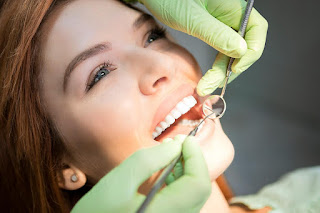Chipped or broken teeth from an injury or general wear and tear can cause you to experience a variety of symptoms ranging from erratic pain when you chew your food to sudden pain when your tooth is exposed to very hot or cold temperatures. In most cases, the pain may come and go, and your dentist may have difficulty locating the tooth causing the discomfort.
A broken or cracked tooth can cause even more pain if the inner pulp of the tooth is exposed. That’s where the tooth’s blood vessels, nerve, and connective tissues are, and if that area becomes inflamed or infected, the pain can be excruciating. The best thing to do when experiencing these symptoms or if you suspect a cracked tooth is to see a dentist immediately.
How Can A Chipped of Broken Tooth Happen?
Teeth are strong, but they can chip, crack or break. This can happen in the following ways:
- Biting down on something hard
- Falling
- Being hit in the face or mouth
- Having cavities that weaken the tooth
- Having large, old amalgam fillings that don’t support the remaining enamel of the tooth
Minor tooth fractures usually don’t cause pain, but if a large piece of the tooth breaks off, it can hurt. The nerve inside the tooth may be damaged. Extreme discomfort also can happen when nerve endings in the dentin are exposed to air, or to hot or cold foods or drinks.
How to Care for a Chipped or Broken Tooth Prior to Visiting a Dentist?
If your tooth is broken, chipped or fractures, see your dentist as soon as possible. If you delay this, your tooth could be damaged further or become infected, possibly causing you to end up losing the tooth. In the meantime, take care of your chipped or broken tooth in the following way:
- Take acetaminophen or another over-the-counter pain reliever if the tooth is painful. Rinse your mouth with salt water.
- If the break has caused a sharp or jagged edge, cover it with a piece of wax paraffin or sugarless chewing gum to keep it from cutting your tongue or the inside of your lip or cheek.
- Eat soft foods and void biting down on the broken tooth.
What are the Types of Tooth Fractures and Breaks?
There are several types of tooth fractures and breaks, these include:
Minor Cracks – These are surface cracks that affect only the outer of the tooth, called the enamel.
Cracked Tooth – This type of fracture involves the whole tooth, from the chewing surface all the way down to the nerve. The pieces remain in place, but the crack gradually spreads.
Broken Cusp – These breaks affect pointed chewing surfaces (the cusps) of the teeth. They usually do not affect the pulp and are unlikely to cause much pain.
Serious Breaks – These breaks go deep enough to expose the nerve. They almost always cause the tooth to hurt and be sensitive. Usually, the broken part of the tooth will bleed.
Split Tooth – This means the that tooth has split vertically into two separate parts. Some teeth as your back teeth, have more than one root. It may be possible to keep one of the roots, which will then be covered with a crown.
Vertical Breaks or Split Root – These cracks start in the root of the tooth and extend upward toward the chewing surface. These breaks are often painful because the area around the root may be inflamed or infected.
Decay-Induced Break – In this case, the tooth has broken or crumbled because a cavity weakened it from the inside out.
What Your Dentist Will Do?
Your dentist will determine the best course of action to fix your tooth after he or she evaluates the damage. If only a small piece of enamel broke off, the repair can usually be done simply in one office visit. A badly damaged or broken tooth may require a more lengthy and costly procedure. Each type of tooth fracture and break requires different treatments. Here are some ways your dentist may repair your broken or chipped tooth.
Dental Filling or Bonding – If the repair is to a front tooth or can be seen when you smile, your dentist will likely use a procedure called bonding, which uses a tooth-colored composite resin. Bonding is a simple procedure that typically does not require numbing the tooth. To bond a tooth, the dentist first etches its surface with a liquid or gel to roughen it and make the bonding material adhere to it. Next, the dentist applies an adhesive material to the tooth followed by a tooth colored resin. After shaping the bonding material to look like a natural tooth, the dentist uses an ultraviolet light to harden the material.
Dental Cap or Crown – If a large piece of tooth breaks off or the tooth has a lot of decay, the dentist may grind or file away part of the remaining tooth and cover it with a crown, or tooth-shaped cap, made to protect the tooth and improve its appearance. Permanent crowns can be made from metal, porcelain fused metal, all resin, or all ceramic.
Root Canal – If the entire top of the tooth is broken off but the root is still intact, the dentist may perform root canal therapy and place a pin or a post in the canal, and then build up enough of a structure onto which a crown can be made. Root canal therapy involves removing the deal pulp, cleaning the root canal and then sealing it.
Dental Veneers – If a front tooth is broken or chipped, a dental veneer can make it look whole and healthy again. A dental veneer is a thin shell of tooth-colored porcelain or resin composite material that covers the whole front of the tooth with a thicker section to replace the broken part of the tooth.




